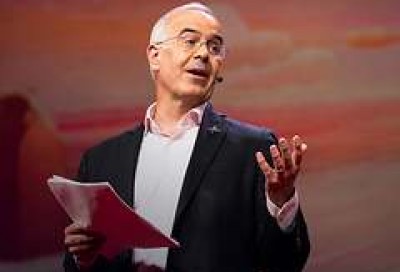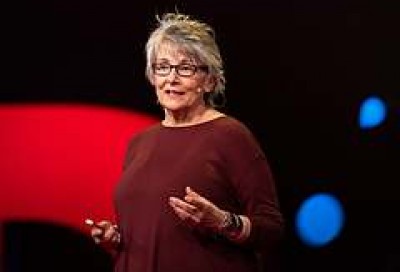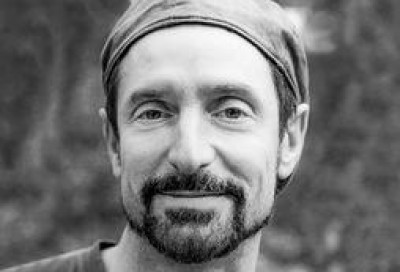你能流利地使用这种语言(甚至不知道它的存在)- Christoph Niemann
人工智能时代口译技术应用研究
王华树 | 国内首部聚焦口译技术应用和教学的著作
新书推荐
口笔译教育与评价国际论坛 二号公告
在厦门大学百年校庆之际,邀您齐聚厦门、共襄盛举
论坛推荐

你能流利地使用这种语言(甚至不知道它的存在)- Christoph Niemann
插图画家克里斯托夫 · 尼曼说,我们没有意识到自己能流利地使用图像语言。在这场令人兴致盎然的谈话中,尼曼利用一幅幅诙谐的、异想天开的图画,带领我们体验了一次有趣的视觉旅程,展示了艺术家们如何挖掘我们的情感和思想——一切都是无言的。
00:00
I'm an artist. Being an artist is the greatest job there is. And I really pity each and every one of you who has to spend your days discovering new galaxies or saving humanity from global warming.
我是一位艺术家。 成为一名艺术家,是最好的工作。 我很同情你们每一个人, 得花时间去发现新的星系, 或者拯救人类免受全变暖的影响。
00:16
But being an artist is also a daunting job. I spend every day, from nine to six, doing this.
(笑声) 但作为一名艺术家, 也是一项艰巨的工作。 我每天从9点到6点都是这样的状态。
00:27
I even started a side career that consists entirely of complaining about the difficulty of the creative process.
(笑声) 我甚至开始了一个副业, 完全为了抱怨创作过程的艰辛。
00:35
But today, I don't want to talk about what makes my life difficult. I want to talk about what makes it easy. And that is you -- and the fact that you are fluent in a language that you're probably not even aware of. You're fluent in the language of reading images. Deciphering an image like that takes quite a bit of an intellectual effort. But nobody ever taught you how this works, you just know it.
(笑声) 但是我今天并不想谈论这些困难, 而想谈谈如何让事情变得简单。 那就是你们, 和你们能理解的流利语言, 而你们可能都没有意识到这一点。 你能流利地阅读图像语言。 解读这些图像 需要运用相当多的智力。但没有人教过你怎样做, 你天生就知道。
01:03
College, shopping, music. What makes a language powerful is that you can take a very complex idea and communicate it in a very simple, efficient form. These images represent exactly the same ideas. But when you look, for example, at the college hat, you know that this doesn't represent the accessory you wear on your head when you're being handed your diploma, but rather the whole idea of college. Now, what drawings can do is they cannot only communicate images, they can even evoke emotions. Let's say you get to an unfamiliar place and you see this. You feel happiness and relief.
大学、购物和音乐。 使语言变得强大的是, 你从中能领略复杂的想法, 并以一种简单而有效的 方式进行沟通。 这些图像代表着完全相同的想法。 但是,当你看到,例如毕业帽, 这并不只是代表在你被授予毕业证书时 戴在你头上的配件, 而是象征着大学教育这个整体概念。 图画可以做的,是它们 不仅可以传达图像, 甚至可以激发情感。 假设你在一个陌生地方看到这个图像, 就会感到快乐和宽慰。
01:43
Or a slight sense of unease or maybe downright panic.
(笑声) 或是有点不安,甚至全然的恐慌。
01:51
Or blissful peace and quiet.
(笑声) 又或是幸福和宁静。
01:56
But visuals, they're of course more than just graphic icons. You know, if I want to tell the story of modern-day struggle, I would start with the armrest between two airplane seats and two sets of elbows fighting. What I love there is this universal law that, you know, you have 30 seconds to fight it out and once it's yours, you get to keep it for the rest of the flight.
(笑声) 但在视觉方面,它们又 不仅仅是图像符号。 如果我想讲述现代斗争的故事, 我会从飞机座椅之间的扶手开始, 还有两个互不相让的胳膊肘。 我喜欢一个通则, 在30秒内,谁占有了扶手, 谁就可以在其余的 飞行时间里拥有这个扶手。
02:20
Now, commercial flight is full of these images. If I want to illustrate the idea of discomfort, nothing better than these neck pillows. They're designed to make you more comfortable -- except they don't.
(笑声) 在商业航班里充满了这些图像。 如果我想说明不舒服的想法, 没有比这些颈枕更好的了。它们旨在让你更舒适—— (笑声) 但常常事与愿违。
02:40
So I never sleep on airplanes. What I do occasionally is I fall into a sort of painful coma. And when I wake up from that, I have the most terrible taste in my mouth. It's a taste that's so bad, it cannot be described with words, but it can be drawn.
(笑声) 所以我从不在飞机上睡觉。 偶尔我会陷入一种痛苦的昏迷状态。 当我醒来时, 我口中会有一种最可怕的味道。 这是一种很糟糕的味道, 难以用文字来形容, 但可以把它画出来。
03:03
The thing is, you know, I love sleeping. And when I sleep, I really prefer to do it while spooning. I've been spooning on almost a pro level for close to 20 years, but in all this time, I've never figured out what to do with that bottom arm.
(笑声) 问题在于,我喜欢睡觉。 当我睡觉时,更喜欢揽着太太。 近20年来,我几乎一直 保持着专业的姿势, 但我从未想过 在下面的手臂怎么办。
03:24
And the only thing -- the only thing that makes sleeping even more complicated than trying to do it on an airplane is when you have small children. They show up at your bed at around 4am with some bogus excuse of, "I had a bad dream."
唯一的事情—— 唯一让睡眠变得比在飞机上睡着 还要困难的, 是当你有了小孩。 他们会在凌晨4点走到你的床边, 编造一些借口,比如 “我做了一个恶梦。”
03:43
And then, of course you feel sorry for them, they're your kids, so you let them into your bed. And I have to admit, at the beginning, they're really cute and warm and snugly. The minute you fall back asleep, they inexplicably -- start rotating.
(笑声) 你当然会为此感到难过, 毕竟是亲生的孩子, 就让他们上床吧。开始时他们表现得很乖, 令你温暖又舒适。 但当你再睡着的那一刻,不知怎的, (笑声) 他们就开始摆出横七竖八的姿势。
04:00
We like to call this the helicopter mode. Now, the deeper something is etched into your consciousness, the fewer details we need to have an emotional reaction.
(笑声) 我们喜欢称之为直升机模式。 (笑声) 另外,有一些更深入的东西 被刻进了你的意识中, 只需要比较少的细节, 就能触动情绪的反应。
04:16
So why does an image like this work? It works, because we as readers are incredibly good at filling in the blanks. Now, when you draw, there's this concept of negative space. And the idea is, that instead of drawing the actual object, you draw the space around it. So the bowls in this drawing are empty. But the black ink prompts your brain to project food into a void. What we see here is not a owl flying. What we actually see is a pair of AA batteries standing on a nonsensical drawing, and I animate the scene by moving my desk lamp up and down.
(笑声) 为什么像这样的图像能引起共鸣呢? 因为我们做为阅读者, 擅长于填补缺失的部分。 当你画画时,有一种负空间的概念。 其核心做法不是绘制实际的物体, 只是画出它周围的空间。 所以图中的碗是空的。 但黑色的墨水会促使 你将食物投射到空间中。 这里看到的并不是飞行的猫头鹰。实际上是一对 AA 电池 放在一张荒诞的画上, 我通过上下移动台灯的光线, 让场景动起来了。
04:58
The image really only exists in your mind. So, how much information do we need to trigger such an image? My goal as an artist is to use the smallest amount possible. I try to achieve a level of simplicity where, if you were to take away one more element, the whole concept would just collapse. And that's why my personal favorite tool as an artist is abstraction. I've come up with this system which I call the abstract-o-meter, and this is how it works. So you take a symbol, any symbol, for example the heart and the arrow, which most of us would read as the symbol for love, and I'm an artist, so I can draw this in any given degree of realism or abstraction. Now, if I go too realistic on it, it just grosses everybody out.
(笑声) 图像只存在于你的脑海中。 那么,需要多少信息 才能触发这样的一个图像? 艺术家的目标是用尽可能少的信息。 我想要达到的极简程度, 就是只需要拿走一个元素, 整个概念都会崩塌。 我作为艺术家, 最喜欢用抽象做工具。 我想出一个称之为抽像仪表的系统, 这是它的工作原理。 你拿其中一个符号, 例如心脏和箭头, 人们都会视之为爱情的象征, 我是艺术家,可以把它画出来, 并以任何现实或抽象的程度来呈现。 如果它过于现实, 就会让所有人难以接受。
05:47
If I go too far on the other side and do very abstract, nobody has any idea what they're looking at. So I have to find the perfect place on that scale, in this case it's somewhere in the middle. Now, once we have reduced an image to a more simple form, all sorts of new connections become possible. And that allows for totally new angles in storytelling.
(笑声) 如果我做得太抽象, 就没人能看懂了。 所以我必须找到平衡点, 位于仪表标尺上接近中间的某处。 一旦将图像变得更简单, 就会增加各种新联系的可能性, 出现不同的,讲故事的新角度。
06:15
And so, what I like to do is, I like to take images from really remote cultural areas and bring them together. Now, with more daring references --
(笑声) 因此我喜欢做的是, 从很偏远的文化区域拍摄图像, 并将它们整合在一起。 更大胆的参考资料——
06:29
I can have more fun. But of course, I know that eventually things become so obscure that I start losing some of you. So as a designer, it's absolutely key to have a good understanding of the visual and cultural vocabulary of your audience. With this image here, a comment on the Olympics in Athens, I assumed that the reader of the "New Yorker" would have some rudimentary idea of Greek art. If you don't, the image doesn't work. But if you do, you might even appreciate the small detail, like the beer-can pattern here on the bottom of the vase.
(笑声) 使我可以获得更多的乐趣。 但最终事情变得太模糊, 就会让你们中的一些人失去兴趣。 因此,作为设计师,关键是要 对关于观众视觉和文化的词汇 有着很好的理解。 这张图片评论了雅典奥运会, 我默认《纽约客》的读者 对希腊艺术有些基本的了解。 否则,图像就不起作用了。 如果你有一定的理解, 甚至会欣赏那些细节, 就像花瓶底部的啤酒罐图案。
07:07
A recurring discussion I have with magazine editors, who are usually word people, is that their audience, you, are much better at making radical leaps with images than they're being given credit for. And the only thing I find frustrating is that they often seem to push me towards a small set of really tired visual clichés that are considered safe. You know, it's the businessman climbing up a ladder, and then the ladder moves, morphs into a stock market graph, and anything with dollar signs; that's always good.
(笑声) 我与杂志编辑们一起反复讨论过—— 他们是文字方面的行家—— 他们的观众,也就是在座的各位, 能够赋予图像比其原本所要表现的意图 更加跳跃式的含义。 而唯一让我感到沮丧的 一件事是,他们经常 迫使我设计一小部分 老套的视觉图像, 认为这样做很保险。 比如商人爬上梯子, 然后梯子移动,变成股票市场图, 任何有美元符号的东西; 这些总是好的。
07:43
If there are editorial decision makers here in the audience, I want to give you a piece of advice. Every time a drawing like this is published, a baby panda will die.
(笑声) 如果观众中有编辑决策者, 我想给你们一些建议。 每次发布这样的图片时, 就会有一只熊猫宝宝死掉。
07:54
Literally.
说真的。
08:01
When is a visual cliché good or bad? It's a fine line. And it really depends on the story. In 2011, during the earthquake and the tsunami in Japan, I was thinking of a cover. And I went through the classic symbols: the Japanese flag, "The Great Wave" by Hokusai, one of the greatest drawings ever. And then the story changed when the situation at the power plant in Fukushima got out of hand. And I remember these TV images of the workers in hazmat suits, just walking through the site, and what struck me was how quiet and serene it was. And so I wanted to create an image of a silent catastrophe. And that's the image I came up with.
怎么判定视觉上的陈词滥调是好是坏? 有一个准则。 这取决于故事背景。 2011 年,在日本的地震和海啸期间, 我正在构想一个封面。 审视经典的符号: 日本国旗, 北斋的 “大浪”,是有史以来 最伟大的绘画之一。 然后故事变了, 福岛电厂的情况失控。 我记得这些穿着 防护服工人的电视画面, 仅仅是走过那地方, 那种宁静和安祥的感觉 却令我印象深刻。 所以我想创造一个静默的灾难图象。 这就是我设计的画面。
08:53
What I want to do is create an aha moment, for you, for the reader. And unfortunately, that does not mean that I have an aha moment when I create these images. I never sit at my desk with the proverbial light bulb going off in my head. What it takes is actually a very slow, unsexy process of minimal design decisions that then, when I'm lucky, lead to a good idea.
我想为各位,为读者们 创造一个顿悟时刻。 不幸的是,这并不意味着 当我创造这些图像时, 正处于灵光乍现的时刻。 我坐在办公桌前的时候, 脑海中象征灵感的灯泡从不会熄灭。 它需要经历一个缓慢的,难熬的过程, 为最细微的设计决策而绞尽脑汁, 如果我的运气还不错, 就会得到一个好主意。
09:19
So one day, I'm on a train, and I'm trying to decode the graphic rules for drops on a window. And eventually I realize, "Oh, it's the background blurry upside-down, contained in a sharp image." And I thought, wow, that's really cool, and I have absolutely no idea what to do with that. A while later, I'm back in New York, and I draw this image of being stuck on the Brooklyn bridge in a traffic jam. It's really annoying, but also kind of poetic. And only later I realized, I can take both of these ideas and put them together in this idea. And what I want to do is not show a realistic scene.
有一天在火车上,我正在尝试解读 窗玻璃上水滴的图形规则。 最后意识到, “哦,模糊不清,上下颠倒的背景, 包含在了一幅清晰的图像中。 “ 我想,哇,真的很酷, 但却不知道如何应用这种场景。 不久之后,我回到了纽约, 在交通拥堵中画出了这张 在布鲁克林大桥上被困的图片。 这个场景让人感到 心烦意乱,但也蕴含着诗意。 后来我才意识到, 我可以融合那两个想法, 来得到一个新想法。 而我的目的并不是展现真实的场景。
09:57
But, maybe like poetry, make you aware that you already had this image with you, but only now I've unearthed it and made you realize that you were carrying it with you all along. But like poetry, this is a very delicate process that is neither efficient nor scalable, I think. And maybe the most important skill for an artist is really empathy. You need craft and you need --
也许就像诗歌那样, 让你意识到你已经拥有这个图象, 但直到现在我才发掘出來, 让你意识到它一直伴随着你。但也就像诗歌一样, 这是一个非常微妙的过程, 既不高效,也不能随意 应用到其他场景中。 艺术家最重要的技能 也许真的是同理心。 你需要草图,你需要——
10:29
you need creativity --
你需要创造力——
10:32
thank you -- to come up with an image like that. But then you need to step back and look at what you've done from the perspective of the reader.
谢谢—— 来构思出这样的图像。 但是你还需要退后一步, 从读者的角度去看你做了些什么。
10:41
I've tried to become a better artist by becoming a better observer of images. And for that, I started an exercise for myself which I call Sunday sketching, which meant, on a Sunday, I would take a random object I found around the house and try to see if that object could trigger an idea that had nothing to do with the original purpose of that item. And it usually just means I'm blank for a long while. And the only trick that eventually works is if I open my mind and run through every image I have stored up there, and see if something clicks. And if it does, just add a few lines of ink to connect -- to preserve this very short moment of inspiration.
我试着通过成为一个更好的观察者, 去成为更好的艺术家。为此,我开始锻炼自己, 我称这个过程为周日草图, 在星期天,我会利用一个 在房子周围随机找到的物品, 并尝试查看该对像 是否可以触发一个 这与该物品的设计初衷无关的想法。 通常,很长一段时间里, 我的大脑都是一片空白。 最终唯一有效的技巧, 就是我能敞开心扉, 并浏览存储在脑海里的每张图片, 试图从中得到灵感。 如果有,只需添加 几行墨水即可建立连接—— 紧握住这个电光石火间的灵感。
11:28
And the great lesson there was that the real magic doesn't happen on paper. It happens in the mind of the viewer. When your expectations and your knowledge clash with my artistic intentions. Your interaction with an image, your ability to read, question, be bothered or bored or inspired by an image is as important as my artistic contribution. Because that's what turns an artistic statement really, into a creative dialogue. And so, your skill at reading images is not only amazing, it is what makes my art possible. And for that, I thank you very much.
我最大的收获就是, 真正的魔法不会发生在纸上。 它只发生在观众的脑海中。 也就是,当你的期望和知识 与我的艺术意图发生碰撞时。 你与图像的互动, 你的阅读、提问、烦恼、厌烦 或受图像启发的 能力, 和我的艺术贡献一样重要。 因为正是这一点让一种艺术陈述 真正变成了创意对话。 所以,你理解图像的能力 不仅令人惊叹, 也是让我的艺术成为可能的原因。 为此,我非常感谢各位。
相关推荐
★★★★★ 5/5







